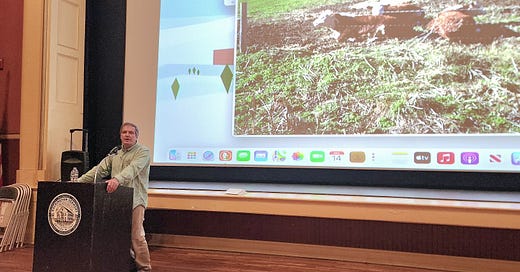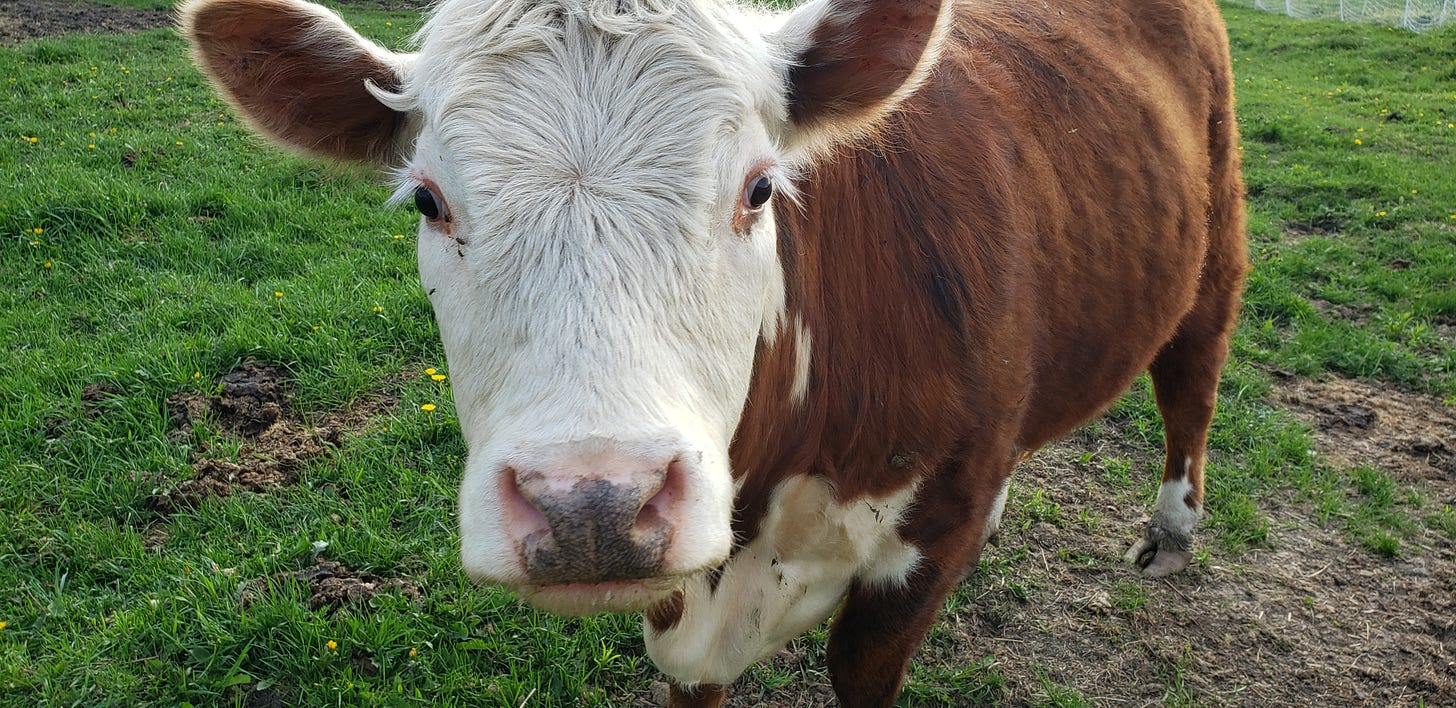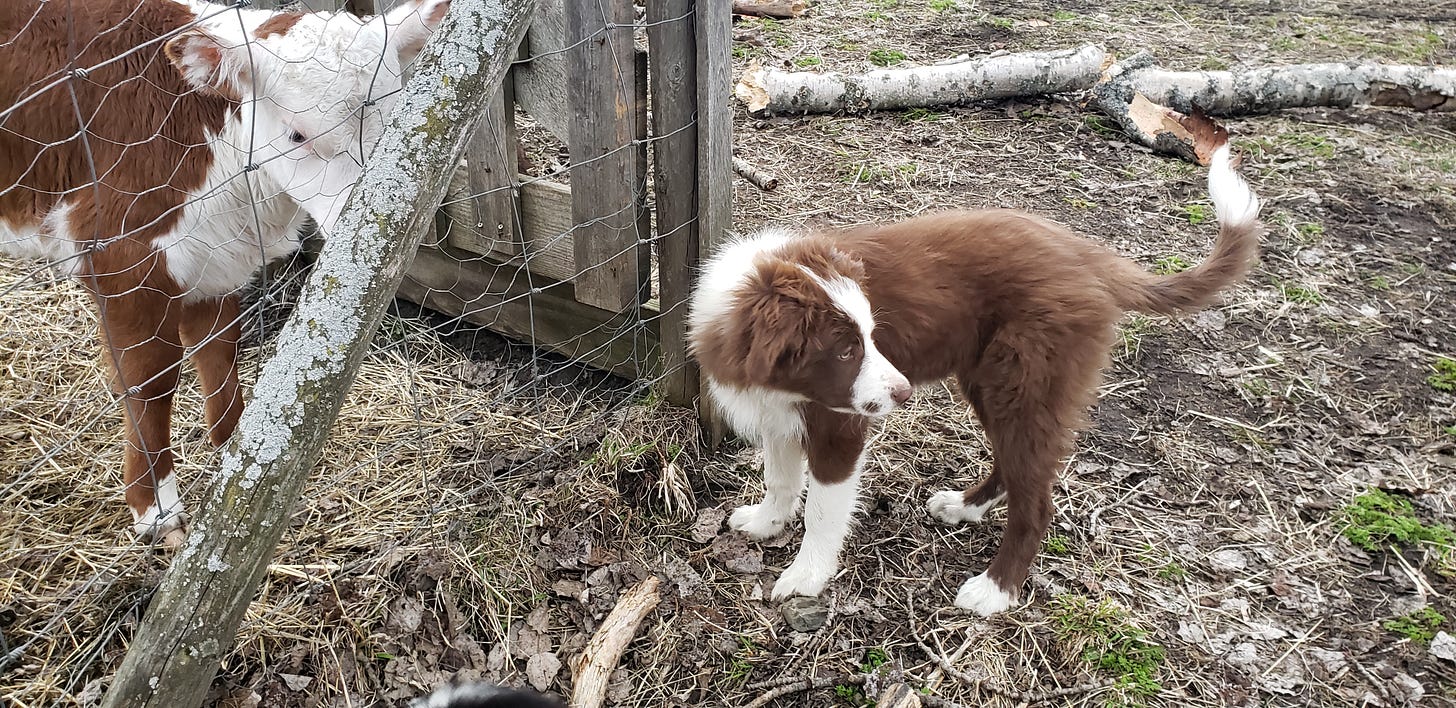[Below are my prepared remarks for Day Two of the Liberty Food Fest in Bellows Falls, which, of course, bears little relation to what I actually said. My references to Joel are to my fellow speaker and ally Joel Salatin, who spoke before me at the Liberty Food Fest. I also include the audio, which is quite different — it includes some sketchy language, a response to the previous speaker who employed derogatory (foul) language toward Republicans — I tried to be nonpartisan in retort. :)]
(Speaking at the Liberty Food Fest with some of my cows as background companions.)
For those of you who don’t own cows, don’t feel left out. That’s the whole point here. So let’s talk about those cows. Cows live in the now. They eat what is in front of them, pasture or trough. They drink from a river or a tub, without thinking what is up or downstream, or who fills the tub. But shut off the water for a day and they sure will complain!
Most modern Americans are more like CAFO cows in stalls. Like veal calves locked in tiny rooms watching TV and TikTok. They don’t look up or down the river any better than cows to see where their food comes from or where their waste goes. We may laugh, but it isn’t funny.
My first book Small Farm Republic made the case for three things: 1) that conservatives could embrace healthy farming and food as a credible environmental policy (Go MAHA!); 2) that ecotoxins are a bigger threat than greenhouse gases, and if you go after the former you get the latter in the bargain; and 3) that cows are not a climate threat; renewables manufacturing that spews forever chemicals is.
(One of our Hereford cows: Mary)
My upcoming book, Farm Hard or Starve, takes us into a deeper awareness of our cow-like imprisonment, building on these same ideas. Now that Americans are looking at their food supplies, what do they see? I want to show them – and you – how ugly and terrifying our situation truly has become.
I recall a scene from the documentary Food, Inc. where animal rights activists seek to rescue CAFO cows and throw open a steel gate — and the cows just stare and won’t leave the pen they are so accustomed to. We humans are much like those cows – Joel and I are trying to fling the gate open and herd humanity back to the land, back to the garden, but they are fearful because they don’t even know how anymore.
Let’s start at the end rather than the beginning. Let’s start with what this nation would look like if (when) there is a major interruption to commerce. That’s all – a pause in business and trade. No gas, no internet, no travel, no fuels for home or car, no food in the grocery stores. Many things could cause this disruption, including war, an EMP, an oil crisis, a meteor, or an earthquake. This is a zombie apocalypse we are talking about right here – people eating each other like in a horror movie; tens of millions crammed into cities like cows in a factory. The water stopped running and the troughs are all empty – where will the human herd go, and what will it do, when it wakes up one day and realizes it is doomed to starve in place? It is then too late to run out of the gate – the gate is closed.
OK, with that cheerful sci-fi image behind us, let’s go back to the beginning. Let’s discuss how we got here, why our vulnerabilities are greater than ever, what voices are sweetly singing to draw us into even greater dependency and CAFO-like vulnerability, and how we open the gates from our imprisonment and stop living like incarcerated beasts with HBO and a hot tub.
Subscribe to Small Farm Republic to unlock the rest.
Become a paying subscriber of Small Farm Republic to get access to this post and other subscriber-only content.
Let me tell you this story with two caveats to bear in the back of your cow-like minds: 1) I didn’t list the threat of currency collapse following hyperinflation: that one is almost certain, and 2) this horror story scenario is inevitable. It is just a matter of when. The Green Revolution is indeed a sort of technological miracle, but it is a second miracle that it has made it this far, and it will take an even greater miracle to keep going indefinitely – I’m a Vermonter who does not desire to put my entire dependency for life on hope for a continuing future industrial “miracle” that is slowly destroying the soil, water, and ecosystem.
How we got here: Vermont and the Great Depression
Vermont was home to about 27,000 dairies in 1929 when the Great Depression struck. The US population was about 100 million then. Today Vermont has about 550 (consolidated) dairy farms, and the nation is home to about 330 million people who have spent the last century migrating into cramped urban and suburban centers.
Vermont was a subsistence farming culture for two centuries and thus well prepared for a Great Depression. How about now? Our demographics have shifted from farmers to state bureaucrats and professionals. We have lost knowledge and farmland, lost animals, and become dependent on tourism and state government “industries.” Growing back farmland in trees to sequester carbon dioxide? What of the food?
We humans, like cows, possess a hierarchy of needs — security, water, food, heat. All of these are threatened by the climate change agenda. Even if we are warming the planet, every proposed solution is 1) generating more ecotoxins; 2) delaying effective response; 3) earning massive short-term profits for a small group of wealthy elites; and 4) increasing our dependency and CAFO-like incarceration. Heat pumps? Vermonters? Really? Being utterly dependent on the electric grid for heat is not how I was raised and would have struck prior generations as ludicrous. How quickly times change….
Our human vulnerabilities are greater than ever.
A brief history of food as a weapon of control or means of great profit.
Siege warfare and the assault against Jerusalem in 70 AD. We watch horror movies in this society; historical realities are far more horrific. We forget that history at our peril – while watching Freddie Kruger and Jason with the hockey mask, we are ignoring Stalin and Mao. The Kissinger Report. Stalin, Mao, Pol Pot. Food is central to all of these stories. Man has known how to control or kill other men with food as weapon for as long as there has been man. Do we think we are now exempt from such threats, so enlightened has our modern barbarism become?
But even without a deliberate plan to starve us into submission, the steady displacement of traditional agricultural methods for efficiency and profit has inexorably exterminated all those local farms, their land, equipment, animals, and humans with the required knowledge. These things are not easily reclaimed, and we abandon them at our peril. First the government said “Get big or get out,” now they say “You are too big so get out,” or worse – only big ag can feed the world.
The Voices of Globalists and Big Ag
We must replace cows with synthetic meats? Cow manure with synthetic fertilizers? Grass blades with GMO monocultures? Vegan diets that spew glyphosate, pesticides, and forever chemicals? The same corporate, university, and government officials that have inflicted this societal illness on our farms and children now say they must control all food production – by force if necessary – to rescue humanity from climate change, famine, inequities, etc. It is all fashioned as social justice but all links directly to Kissinger’s top secret national security “Report.” We are in an international battle over food policy, folks. A battle between good and evil, globalist and local, human and corporate machine. Our very lives and those of our grandchildren depend on the outcome.
Food Inflation is Linked to Energy/Currency
This entire food system is a brief blip in time, an illusion. It is built upon cheap energy. The day that energy becomes costly or unavailable (e.g., OPEC and the 70s) is the day the entire system fails to be profitable and instead begins to unravel and reverse. Grass-fed versus grain-fed. Cows v chickens v sheep v. pigs: chickens and pigs are dependent on grains manufactured by industrialists and vulnerable to inflation; cows and sheep can be reared solely on grass. (Is that perhaps a reason for food corporations to dislike cows?)
Either energy prices can go up, or the dollar can go down (inflation): either way the entire Green Revolution will then unravel. Like Vermont’s sheep industry evaporated when wool prices plummeted, or its dairy industry collapsed when milk prices dropped by half in 1929, the agricultural markets are very real and unforgiving. The current industrial agricultural system is not economically sustainable because it depends on an infinite supply of cheap energy and that supply is finite, and also at risk of disruption. The whole miracle of modern food is a magic trick or mirage dependent completely on fossil fuels, especially oil and natural gas. Neither is it environmentally sustainable – aquifers, soils, chemicals, limits of biology. The fiat currency is just that – and intangible. Economists generally define hyperinflation as 50%/month. A $100 trillion Zimbabwe note can be bought for about $150.00 US; Venezuela and Marxism give us great examples of sloppy monetary policy. Same thing here – social programs and renewables spending must be paid for, or else the currency fails under the strain. There is no American exceptionalism from math. How the mighty always fall, and that will one day include the mighty dollar!
Let’s consider the historical context of where we find ourselves today. 1920s farming in VT to 1970s “back to the land” fad to 2025 and MAHA. These are three different movements — Vermonters were subsistence farmers, and in the 1929 crash they farmed to eat. The 1970s OPEC crisis engendered a fad that waned once oild prices subsided. MAHA is about a dawning awareness that something is very rotten not in Denmark but on our grocery store shelves — or better, it is not rotten because it is so saturated with chemicals that even bacteria can’t grow in it. Today’s food is not your grandmother’s food — this is an utterly different food system than in the 1970s when GMOs were just mounting the technology horizon.
Survival, to profitability, to OPEC crisis, to very real substantive change. This is what we talk about a lot – farming is hard but priceless, painful but enriching. All of us depend on farmers even if we don’t farm. Let us not fall victim to the path of Rome, or the path of desertification of our most fertile lands…..
(Stay tuned to Small Farm Republic for Part Two of A Case For Cows!)









I was taught that the “smart and successful people” were in banking, politics or science. I have unlearned that edict. The most brilliant people I have encountered are on small, local farms and ranches. There really is not anything they cannot do, from land and animal management to fixing fences, welding things, irrigation, repairing equipment. I learned that baling twine is an invaluable tool. I even once tied a truck battery in with it when a clip broke until I could obtain a proper replacement and used baling twine to create a pulley system to put a steel bovine maternity pen together. The work ethic on small farms and ranches is unparalleled. People don’t seem to want to believe that food as a control mechanism is a reality but I am certain of it. Thanks for spreading awareness.
I moved to Vermont 20+ years ago from NJ ( semi-rural area) because of my relationship with my future wife living here. I made a living being in the remodeling business in NJ and wondered what the market was like in Vt. At the time I took the chance that I would be able to 'make it' here. Well, 20+ years later, I am still here. My wife is no longer on this earth plane however I am grateful that I still live here. I am a better 'fit ' here than I was down there. When I do go down to visit family I am still amazed at the differences in the two cultures. Two states, virtually the same size with one having a population about 15X larger! My brother and his wife live in a modest home on the Jersey shore which is very close to a rural area similar to VT. They live right next to the one of the largest supermarkets I have ever seen. It is almost mind boggling as to the width, depth and breadth of the food inventory! In Vt, I buy my meats, produce, eggs, breads and syrup locally. Whatever else I need, I look to support the local market when possible. At this supermarket in NJ, virtually nothing is local! (except for some breads and baked goods). Even the Jersey Tomato (which is actually its own specie and can only be grown in NJ or Israel) is only available when you go into the rural farm areas and get them from the local farm stands. My question is: How long can a system like this be viable in NJ? We have a simpler life up here and also a simpler mentality. There is more human compassion here and we can also adapt to change much better. I always look at our cows up here while driving and marvel at their magnificence. They are a simply creature and a symbiotic partner to the human (if we let them). I always look for them when I am in NJ visiting. You can find them, however you have to want to look for them! Most people down there don't even care. I do and that's why I am grateful that I live here....